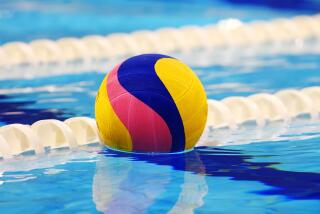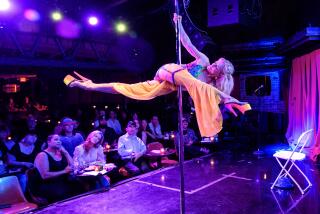Training for the Tenderfoot : Batchelor’s Tri-Valley Polo Club Offers Lessons for Beginners Not Interested in Horsing Around
- Share via
Lou Miraglia reaches around the muscular neck of his chestnut quarter horse and swats a 6-inch rubber ball with his wooden mallet. The soft, lumpy ball skips across the sod-covered polo arena while Miraglia, galloping ahead of it, moves into position to take another shot on goal.
Unable to maneuver his 1,200-pound mount into scoring position, Miraglia whacks the ball to an approaching teammate. A horse ridden by Kathy Batchelor romps past Miraglia and Batchelor intercepts the pass and whacks it toward the opposite end of the oval-shaped arena.
Miraglia, 27, of Canoga Park has played polo less than three years and already he is addicted to the sport. He owns four polo ponies and a horse trailer and competes in several tournaments a month.
Twice a week, Miraglia and his fiancee Diane Kay take lessons and practice in scrimmage sessions at the Tri-Valley Polo Club in Chatsworth. There, Miraglia hones his mallet-wielding skills and learns new tactics for a sport that he probably will never master.
“You want to get to the point where you feel like you’re one animal instead of two,” Miraglia said. “But I don’t think I’ll ever master everything.”
Miraglia believes he is well-suited for polo. The sport offers the right mixture of speed, teamwork and peril.
“There have been many occasions where somebody has taken the front legs out from under my horse and I’ve ridden it on its knees,” Miraglia said. “I get bored really fast so I need to be involved in something that has speed to it. Polo is a real adrenaline rush.”
Miraglia learned polo from Batchelor, owner of the Tri-Valley Polo Club, the only club in the Valley that offers outdoor polo lessons. After three months of lessons, Miraglia bought his first two horses and added two more soon afterward.
“He likes to go all the way with things,” said Kay, 25, of Canoga Park.
Batchelor has 68 polo ponies and oversees a cluster of stables and a polo arena on a 10-acre ranch tucked into the mountains above Chatsworth. She teaches students and stages tournaments in the arena, which measures 150 yards by 300 yards.
In arena polo, two teams of three players each try to outscore one another during a 28-minute match. The match is divided into four seven-minute chukkers. The riders swat a 6-ounce rubber ball with wooden mallets and aim for the opposition’s goal mouth, which is 10 feet wide.
As in soccer, bumping and bodily contact is allowed as long as the angle of collision is no greater than 45 degrees. A player also can “hook” an opponent by thrusting a mallet in the way of an opponent’s mallet.
But the real hook of polo is the equine experience.
“Horses are much easier to train because they don’t ask why,” Batchelor said.
Batchelor says she has yet to own a horse she couldn’t train for polo. Some aren’t worth teaching because they’re too flighty or mean, but any horse is capable of learning the game, she said.
The same cannot be said for Batchelor’s human students.
“I’ve had students who were flat naturals,” Batchelor said. “But some people who have wanted to try this have just scared me. There have been some students who have weighed about 380 pounds. I just don’t have the equipment for someone that big.”
Many of Batchelor’s students are businessmen or professionals: accountants and stockbrokers seeking a physical and outdoor sport.
“Horses are good therapy for people with a lot of stress in their jobs,” Batchelor said. “They work with you and give so much back. There’s not a horse in the world that will call you an idiot when you make a bad shot. They are 1,200 pounds of willingness and that’s a good feeling.”
Although the only requirement for beginning students is that they be able to mount the horse without assistance, Batchelor’s program is geared for riders interested in pursuing the sport and buying their own horses, which cost between $2,500 to $5,000.
“We can’t accept students who are not prepared to advance,” she said. “When they develop to the point that they are ready for competition, then they are ready to invest in livestock.”
In an introductory lesson Batchelor teaches the rules of polo, how to swing the mallet and the basics of good horsemanship. A student does not need to be an expert horseman, but the sport requires endurance and coordination.
Batchelor has taught polo for 12 years and trained horses most of her life. She has played competitive polo throughout California and has a 1-goal rating by the U. S. Polo Assn., which rates and evaluates only the top players. The USPA rates players’ ability on a goals scale of 1 to 10. The top indoor players worldwide have a rating of 9 goals.
Arena polo in the Valley has enjoyed popularity in part because of the Los Angeles Colts of the American Polo League. Professional indoor polo, which is now in its sixth year in the Los Angeles Equestrian Center, draws nearly 4,000 spectators to regular-season matches. The sellout crowds are often dotted with celebrities.
Polo became a Southern California staple in the 1930s and ‘40s. Celebrities such as Spencer Tracy and Clark Gable flocked to the Sunday afternoon matches at the Pacific Palisades ranch of humorist Will Rogers. The country-club atmosphere appealed to Hollywood’s elite.
Outdoor polo is still played at Will Rogers State Park. Locally, it is played at the Tri-Valley Polo Club, in Moorpark and at the Equestrian Center, located in Griffith Park. The Equestrian Center is popular with polo enthusiasts who would rather view the sport from a safe vantage point than mix it up in the arena.
Batchelor believes that one lesson is all it takes for the curious to discover whether polo is right for them.
“We will give them a good idea of whether they have the right physical and mental conditioning for the game,” she said.


